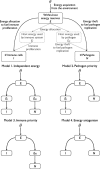Disentangling the interaction among host resources, the immune system and pathogens
- PMID: 24350974
- PMCID: PMC4264941
- DOI: 10.1111/ele.12229
Disentangling the interaction among host resources, the immune system and pathogens
Abstract
The interaction between the immune system and pathogens is often characterised as a predator-prey interaction. This characterisation ignores the fact that both require host resources to reproduce. Here, we propose novel theory that considers how these resource requirements can modify the interaction between the immune system and pathogens. We derive a series of models to describe the energetic interaction between the immune system and pathogens, from fully independent resources to direct competition for the same resource. We show that increasing within-host resource supply has qualitatively distinct effects under these different scenarios. In particular, we show the conditions for which pathogen load is expected to increase, decrease or even peak at intermediate resource supply. We survey the empirical literature and find evidence for all three patterns. These patterns are not explained by previous theory, suggesting that competition for host resources can have a strong influence on the outcome of disease.
Keywords: Consumer-resource theory; epidemiology; immunology; modelling.
© 2013 The Authors. Ecology Letters published by John Wiley Sons Ltd and CNRS.
Figures


 (solid),
(solid),  (dashed) and
(dashed) and  (dot-dash). The proximate resource for the immune system is highlighted in dark grey and the proximate resource for the pathogen is highlighted in light grey. Panels e–h show the immune abundances when the pathogen is present (solid, N+) and absent (dashed, N−). Note that increasing energy acquisition increases the number of immune cells even in the absence of infection because of the baseline immune allocation parameter aB. Panels i–l show the pathogen load. Panels m–p show the net gain rate (solid, point-up triangles) and per capita loss rate (dashed, point-down triangles) of the pathogen's resource (the numerator and denominator, respectively, of the equations in Table2). Note that these quantities have different units (1/time vs. 1/pathogens/time). Parameter values are given in Table1.
(dot-dash). The proximate resource for the immune system is highlighted in dark grey and the proximate resource for the pathogen is highlighted in light grey. Panels e–h show the immune abundances when the pathogen is present (solid, N+) and absent (dashed, N−). Note that increasing energy acquisition increases the number of immune cells even in the absence of infection because of the baseline immune allocation parameter aB. Panels i–l show the pathogen load. Panels m–p show the net gain rate (solid, point-up triangles) and per capita loss rate (dashed, point-down triangles) of the pathogen's resource (the numerator and denominator, respectively, of the equations in Table2). Note that these quantities have different units (1/time vs. 1/pathogens/time). Parameter values are given in Table1.

References
-
- Alizon S. van Baalen M. Acute or chronic? Within-host models with immune dynamics, infection outcome, and parasite evolution. Am. Nat. 2008;172:E244–E256. - PubMed
-
- Antia R, Levin BR. May RM. Within-host population dynamics and the evolution and maintenance of microparasite virulence. Am. Nat. 1994;144:457–472.
-
- Beisel WR. Synergism and antagonism of parasitic diseases and malnutrition. Rev. Infect. Dis. 1982;4:746–750. - PubMed
Publication types
MeSH terms
LinkOut - more resources
Full Text Sources
Other Literature Sources

